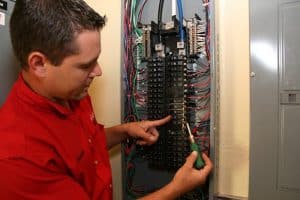
Electrical power is pumped from the utility company through a service drop electrical power line and into your home. The service drop electrical line passes this power on to your main electrical panel, which in turn distributes it as needed. The service drop power line is continually supplied with power and so never shuts off. However, you can stop power from coming into your home by shutting off the main electrical panel.
Having some basic knowledge of the main electrical panel is important for every homeowner. This knowledge will play a role when you need to troubleshoot simple issues, or even discuss complex ones with your electrician. It’s also important for your safety to understand the workings of the electrical panel.
It’s not strange to find anything electricity-related confusing as a homeowner. So we will go easy and start with some facts about the electrical panel.
- The electrical panel can also be called a breaker box or circuit breaker box.
- The major function of the circuit breaker box is to regulate the power coming into the home and its safe distribution across outlets and other electrical components.
- If you plug in too many electrical appliances, a demanding appliance, or there are power surges, the electrical breaker trips and eventually the power is cut to protect your electrical system from damage.
- Breaker boxes are the same in function but are designated by amps/capacity and the number of breakers they can accommodate.
- Circuit breakers themselves come in different types, which are designated by how many volts they can handle.
- The circuit breaker in your home can only perform at 80% of its capacity. Hence when you need to install or upgrade a breaker box, your electrician calculates your voltage needs leaving room for maximum capacity.
- The cost of upgrading your electrical panel depends on factors like the state of your electrical system.
Now, the electrical panel is less intimidating and we can go a bit deeper.
What’s inside the circuit breaker box?
The big metal box is filled with wires, switches, and stuff you may find overwhelming. But it’s quite simple. The service drop line connects to two large terminals known as lugs located at the top of the panel. The breakers you see in two rows are branch circuit breakers. They include 20amp circuits for outlets, areas like the kitchen and garage; 15amp circuits feed lighting and other outlets; larger breakers with 30, 40, or 50 amps appear as double-pole breakers with double-size levers. They supply power to demanding 240volt appliances.
The branch circuit breakers are mounted on hot bus bars which connect to them. There is also the neutral bus bar and grounding bar. A heavy copper wire runs from the grounding bar, outside the panel and through a long copper rod driven into the ground. This transfers electricity safely to the ground for your protection.
Panel sizes include 60, 100, 200 amps and more. Panels are installed according to your home needs.
If you think you may need a panel upgrade or replacement, our electricians near you can help examine your electrical panel and recommend the best course of action. Call Elcon Electric to get on schedule today!

